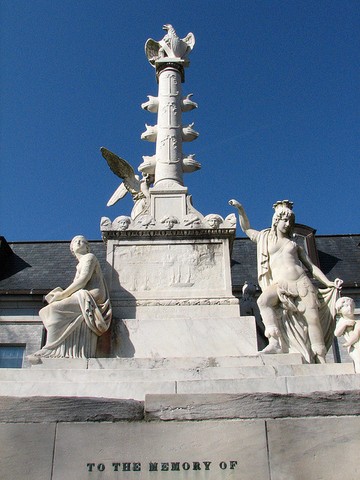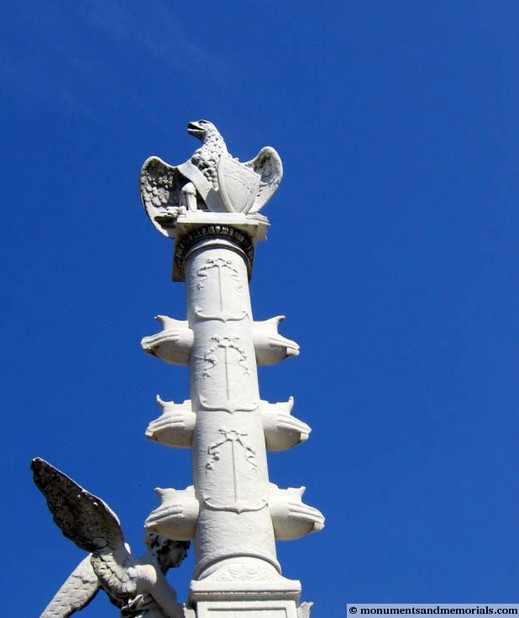Tripoli Monument
Introduction
Text-to-speech Audio
Located on the United States Naval Academy campus, this monument commemorates the servicemembers who participated in the First Barbary Wars. The Tripoli Monument was carved in 1806 in Italy before being brought to the Washington Navy Yard in 1808 and moved to the US Capitol building in 1831. In 1860, the monument was moved to the United States Naval Academy. The First Barbary War was fought off the Mediterranean coast of Tripoli between 1801-1805 in response to pirates from the Barbary States who seized American merchant vessels and held crew members for ransom. President Thomas Jefferson initially refused to pay the ransom to the pirates. Instead, he sent American forces to the region in an ambitious plan to reshape control of the region.
Images
The Tripoli Monument at the United States Naval Academy

Close-up of the eagle perched at the top of the monument.

Backstory and Context
Text-to-speech Audio
The Tripoli Monument honors American seaman and marines who participated in the First Barbary War which saw the first effort of the United States to exert influence in North Africa. American forces responded to pirates operating from Tripolitania and Morocco, but in the end, President Jefferson decided to compromise with local leaders rather than using force of arms.
The Tripoli Monument is made of Carrara marble and sandstone and was the first monument at the nation's capitol of Washington D.C. In fact, for thirty-five years, this was the only monument in the District of Columbia and it withstood the War of 1812.
The Tripoli Monument was brought to the U.S. on the USS Constitution from Italy and erected in honor of Captain Richard Somers, Lieutenant James Caldwell, James Decatur, Henry Wadsworth, Joseph Israel, and John Dorsey who perished in the campaign at Tripoli.
The conflict's origins are complex, but the turning point occurred in October of 1800 when Tripolitan pirates took control of the American vessel Catherine. After some deliberation between the pirates and the captain of the ship, they decided they would ask president Jefferson for ransom money and gave him six months to reply or they would declare war on the U.S. Jefferson sent a letter to Pasha Karamanli (Tripolitan pirate leader) stating he was sending a squadron of ships into the Mediterranean for observation. Jefferson initially decided not to pay the ransom.
In 1803, Tripolitan pirates captured the Philadelphia intact after it ran aground on a coral reef as it patrolled one of Tripoli’s main harbors. William Bainbridge, all officers, and the crew were taken as hostages and held on the mainland. The Philadelphia ended up being used against American ships when it was anchored and used as a gun battery. After a myriad of blockades and raids, and under threat of continued bombardments, as well as a plan to restore his deposed brother to the throne Yusuf Karamanli signed a treaty. The treaty stated that All Americans held by the Tripolitans will be released as well as all Tripolitans captured shall be released and a sum of $60000 would be paid for the American prisoners.
Sources
Huff, Elizabeth, Priscilla Roberts, and Richard Roberts. "The First Barbary War". Monticello.Org, 2018. https://www.monticello.org/site/research-and-collections/first-barbary-war.
Mullen, Abigail G. ""Good Neighborhood with all": Conflict and Cooperation in the First Barbary War, 1801-1805."ProQuest Dissertations Publishing, 2017.
Leiner, Frederick C. To the Walls of Derne: William Eaton, the Tripoli Coup, and the End of the First Barbary War. Vol. 82 Society for Military History, 2018.
